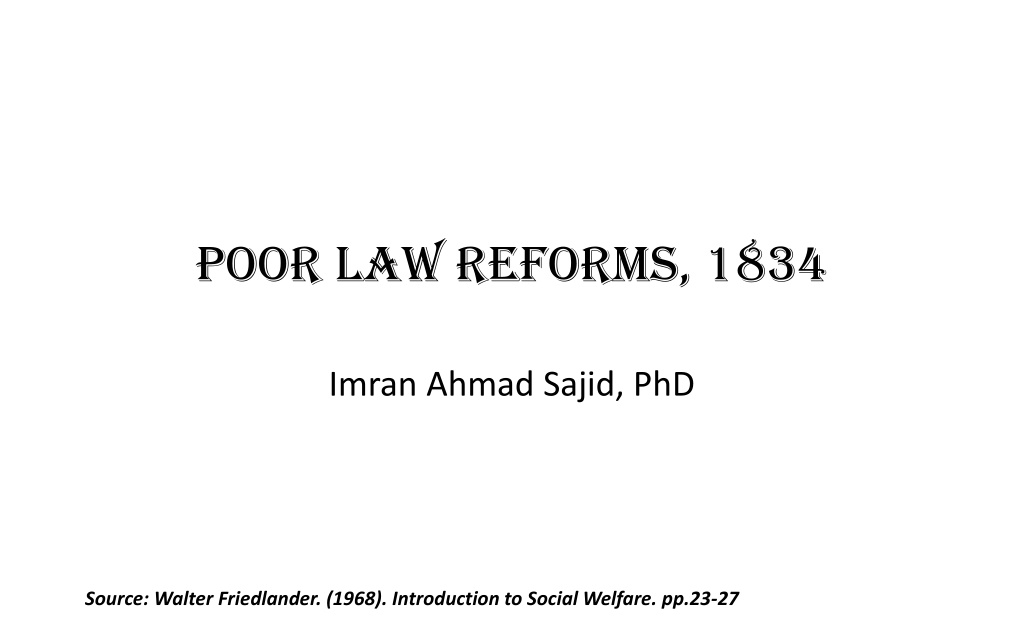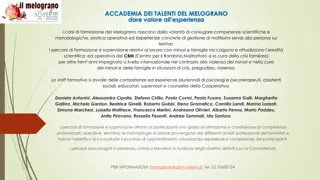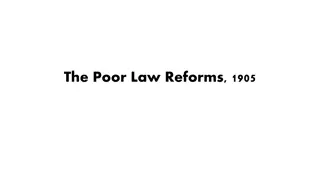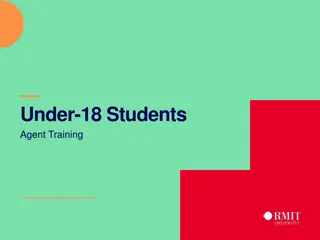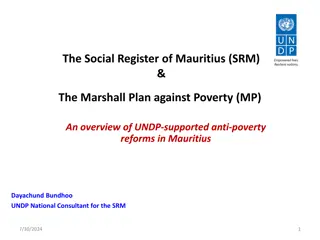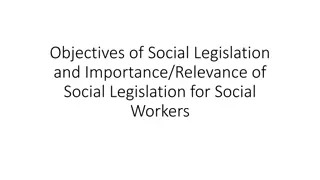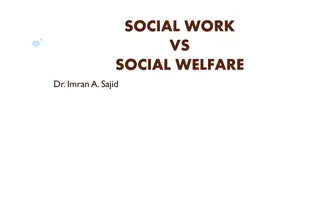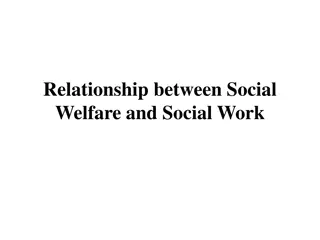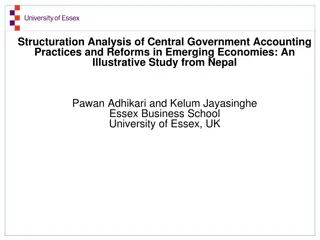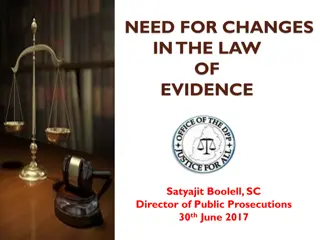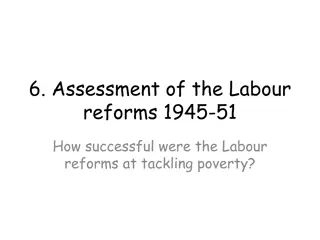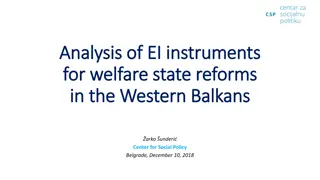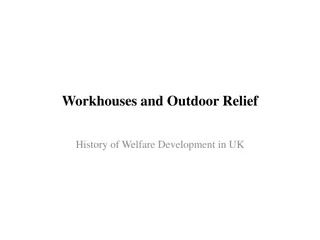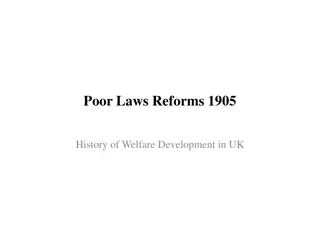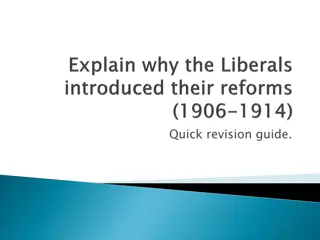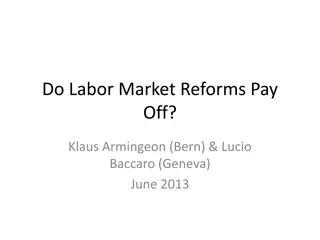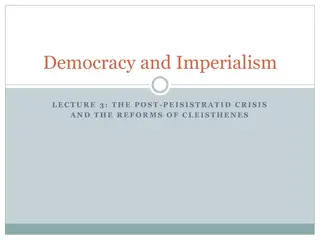Poor Law Reforms and Social Welfare Overview
The 1834 Poor Law Reforms in England led to the establishment of workhouses and changes in relief systems to address poverty. With recommendations to abolish the old relief system, focus shifted to providing outdoor relief to specific vulnerable groups and promoting the Principle of Less Eligibility. The reforms aimed to reduce government expenditure, establish new workhouses, and tackle issues like overcrowding and family breakdown. The survey highlighted disease as a major cause of destitution and dependency on public relief, emphasizing the impact of unhealthy living conditions and malnutrition, particularly in urban slums.
Download Presentation

Please find below an Image/Link to download the presentation.
The content on the website is provided AS IS for your information and personal use only. It may not be sold, licensed, or shared on other websites without obtaining consent from the author.If you encounter any issues during the download, it is possible that the publisher has removed the file from their server.
You are allowed to download the files provided on this website for personal or commercial use, subject to the condition that they are used lawfully. All files are the property of their respective owners.
The content on the website is provided AS IS for your information and personal use only. It may not be sold, licensed, or shared on other websites without obtaining consent from the author.
E N D
Presentation Transcript
Poor Law Reforms, 1834 Imran Ahmad Sajid, PhD Source: Walter Friedlander. (1968). Introduction to Social Welfare. pp.23-27
1. Rising Tax Rates Disadvantages of Partial Relief System 2. More Poverty and Pauperism 3. Political Opposition
Royal Commission for the Inquiring into the Administration & Practical Operation of the Poor Laws 1832 Chairman: Prof. Nasau W. Senior (economist) Report: 1. The partial relief system failed to bring to work the children and able bodied poor 2. It made them permanent beggars 3. Tax is abused by farmers/landlords, and manufacturers etc
1. PRS failed to bring to work the children and able bodied poor Royal Commission for the Inquiring into the Administration & Practical Operation of the Poor Laws-- 1832 2. It made them permanent beggars Report 3. Tax is abused by the farmers/landlords, and manufacturers etc Chairman: Prof. Nasau W. Senior (economist) Commission: a group of people authorized to carry out a duty
1. Abolish the PRS 6. Central Board of Control of Poor Laws 2. Place all able bodied poor in workhouses RECOMMENDATIONS 3. Provide outdoor relief only to the aged, disable, widows with young children 5. Introducing Principle of Less Eligibility 4. Coordination of the poor relief into Poor Law Unions PoLE: put the poor recipients in a condition less desirable than that of a lowest paid worker in the community.
Results/Outcomes 1. 2/3 Reduction in government expenditure on poor relief 2. Abolishing alms houses and establishing 200 new workhouses. 3. Immoralities, delinquencies, overcrowding, family breakup 4. Principle of less eligibility forced people to accept any labour Desrail: To be a poor in England is a Crime
Survey: Poor Law Commission with assistance of medical inspectors (Dr. Southwood Smith) Major cause of destitution is disease among the lower classes. Disease deprived the laborer and his family of the means of livelihood and made them dependent upon public relief.
unhealthy housing and living conditions and by malnutrition DISEASE Urban Slums Overcrowded, both sexes sleep together in one bed Immoralities, promiscuity, quarrels, delinquency, and rapid spread of contagious disease Poor Quarters No water supply and drainage; polluted drinking water of the rivers, deficient pipelines No outside toilets and no sewers in the streets Refuse thrown into public gutters No scavenger service or regular street cleaning Dead Bodies Failure to bury the dead unless the poor law guardians assumed the cost of funeral
Edwin Chadwick: member Poor Law Commission First pioneer of public hygiene Brought the issue to the parliament Developed a program of protection against contagious diseases by sanitary provisions for water system, sewage, and drainage. Advocated establishment of parks and flower gardens for the recreation of the population. Free public vaccination against cholera, typhus, and smallpox was introduced in 1840 (thanks to Chadwick s insistence) Public Health Act of 1848, established General Board of Health Fight against epidemic, Improvement of housing conditions in slums Establishment of sanitation BOARD: a group of people chosen to make executive or managerial decisions for an organization
